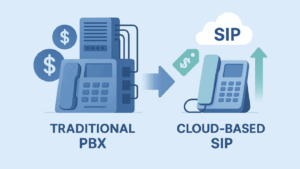
Beginner’s Guide to Understanding How SIP Works
What Is SIP, and How Does It Work?
Session Initiation Protocol (SIP) is a powerful technology that underpins modern communication systems, enabling efficient and scalable internet-based voice and multimedia transfers. If you’re a small to medium-sized business looking to streamline communications, understanding how SIP works is essential.
SIP is crucial because it supports voice over internet protocol (VoIP) and multimedia messaging, facilitating services such as voice calls, video conferences, and instant messaging over the internet. This means that instead of relying on traditional telephone lines, which can be costly and inflexible, businesses can manage their communications through the internet with greater control and lower cost.
SIP is a signaling protocol used for initiating, maintaining, and terminating real-time sessions that involve video, voice, messaging, and other communications applications and services between two or more parties. It’s adaptable and can work over several transport protocols, offering robustness in network communications.
In this guide, we will delve deeper into how SIP works, the components that make up SIP technology, and the tangible benefits it can bring to your business. Whether you’re aiming to enhance remote collaboration capabilities or extend your communication reach without substantial overheads, SIP offers a streamlined, cost-effective solution.
How SIP Works
What is SIP?
Session Initiation Protocol (SIP) is a powerful technology used to initiate, manage, and terminate sessions in an IP network. These sessions can include voice calls, video conferences, and other forms of multimedia communication. With nearly 80% of companies using video conferencing regularly, it’s no wonder SIP has come to the forefront. Unlike traditional phone systems that rely on physical network connections, SIP operates over the internet, offering greater flexibility and significant cost savings.
How Does SIP Work?
SIP functions by sending messages between devices to establish, manage, and terminate connections. It works in conjunction with other protocols like RTP (Real-Time Transport Protocol) which handles the actual delivery of voice and video over the network. Here’s a simple breakdown of the process:
- Initiation: A SIP device sends a message to another device to start a session. This message includes information about the sender and the type of session proposed.
- Negotiation: The receiving device may accept the session, reject it, or negotiate parameters (like codec types for voice compression).
- Data Transfer: Once the session parameters are agreed upon, data transfer begins using RTP.
- Termination: Either party can send a message to end the session at any time.
SIP vs. VoIP
While often used interchangeably, SIP and VoIP are not the same. VoIP is a broad term that refers to any phone call made over the internet instead of traditional telephone lines. SIP, on the other hand, is a specific protocol used to implement VoIP. It can also manage other types of multimedia communications, not just voice.
- VoIP focuses solely on voice communication.
- SIP handles voice, video, and other messaging services.
Understanding this distinction is crucial for businesses looking to implement these technologies effectively. By leveraging SIP, companies can create a unified system that handles a variety of communication types, enhancing overall efficiency and collaboration.
In the next section, we’ll explore the key components of SIP, including how SIP trunking can further optimize your communication infrastructure.
Key Components of SIP
Understanding SIP Trunking
What is SIP Trunking?
When it comes to understanding how SIP works, you have to start with SIP Trunking. SIP Trunking is a method of sending voice and other communication services over the internet. It uses the SIP to connect traditional phone systems to the internet. By replacing older telephone lines (like PRI), SIP Trunking allows businesses to communicate more efficiently and at a lower cost. And this transition is also becoming a necessity. CNN Business reports phone service providers are likely to phase out landlines soon.
Benefits of SIP Trunking
– Cost-effective: Reduces call costs and eliminates the need for physical lines.
– Scalable: Easily adjusts the number of channels to handle increased calls without significant infrastructure changes.
– Flexibility: Quickly add or remove services and features as needed.
For businesses looking to cut down on communication expenses while maintaining quality, SIP Trunking offers an excellent solution. Learn more about how SIP Trunking can reduce costs and maximize efficiency here.
Session Management in SIP
How SIP Manages Sessions
SIP is pivotal in managing the setup, maintenance, and termination of sessions in real-time communications. Here’s how it works:
- Initiation: SIP addresses are used to initiate a session between two or more parties. This could involve voice calls, video calls, or messaging.
- Maintenance: During the session, SIP manages the signals and controls the data transfer ensuring consistent quality and service.
- Termination: Once the session is complete, SIP also handles the disconnection, ensuring resources are efficiently released.
Key Protocols Used
SIP works with various protocols to ensure efficient delivery of communication services:
– RTP (Real-Time Protocol): Manages the delivery of real-time data such as audio and video.
– SDP (Session Description Protocol): Describes multimedia sessions to help initiate and manage communication sessions.
Understanding these components is crucial for businesses looking to leverage SIP technology for enhanced communication solutions. As we explore further, the ability of SIP to support scalable and flexible communication options becomes evident, making it a cornerstone of modern business communications.
Benefits of Implementing SIP in Business
How SIP Works to Enhance Remote Work
Connectivity: SIP technology excels in connecting remote teams. Regardless of where employees are located, SIP enables seamless voice, video, and messaging communication. This connectivity is crucial, especially as businesses continue adapting to remote work models.
Collaboration: With features like video conferencing and instant messaging, SIP fosters a collaborative environment. Teams can share files, collaborate on documents, and manage projects efficiently without being in the same room.
Efficiency: SIP reduces the time and effort required to manage communications. By integrating various communication tools into one platform, businesses can streamline processes and improve productivity.
SIP and Business Scalability
Cost Reduction: SIP eliminates the need for traditional phone lines, reducing monthly communication expenses. By using internet connectivity, SIP trunks offer a more cost-effective solution compared to old-school PRI lines.
Flexibility: Businesses can scale their SIP solutions based on current needs. Whether it’s expanding or reducing the number of channels, SIP adapts to your business demands without the need for physical installations or disruptions.
Mobility: SIP supports a dynamic workforce. As businesses grow and open new locations, SIP’s mobility ensures that communication remains uninterrupted and consistent across all branches.
Resource Management: With SIP, IT departments can manage resources more effectively. The ability to monitor and adjust communication needs in real-time allows businesses to optimize their operations and reduce wastage.
Network Expansion: SIP facilitates easy expansion of network capabilities. As businesses grow, adding lines or features is straightforward, supporting expansion without significant infrastructure changes.
In conclusion, SIP not only supports modern business needs like remote work and scalability but also offers significant cost savings and operational efficiencies. Understanding these benefits can help businesses make informed decisions about their communication strategies.
Common Misconceptions About SIP
Debunking SIP Myths
When exploring new technologies, it’s natural to encounter some myths and misconceptions. Here, we address common misunderstandings about SIP (Session Initiation Protocol) to clarify its security, complexity, and limitations.
Security Concerns:
One of the biggest myths about SIP is that it is inherently insecure. This is not true. While basic SIP (without enhancements) does not encrypt data, solutions like SIP over TLS (Transport Layer Security) and SRTP (Secure Real-Time Transport Protocol) provide robust encryption for both signaling and media streams. This means that SIP can be configured to offer high levels of security, protecting against eavesdropping and data tampering. Learn more about SIP security.
Complexity:
Another common misconception is that SIP is too complex for average users. In reality, SIP’s design is quite straightforward, especially when compared to older telecommunication systems. Many SIP providers offer user-friendly interfaces and full support, making installation and management quite manageable for non-experts. Understanding SIP setup.
Limitations:
Some believe that SIP is limited in functionality. However, SIP is incredibly versatile and supports voice, video, and other multimedia communications, which can be integrated into various applications and services. Its adaptability makes it suitable for a wide range of business needs.
Reliability:
Concerns about the reliability of SIP often stem from experiences with lower-quality VoIP services. However, high-quality SIP trunk providers leverage robust infrastructure and network redundancies to ensure high availability and reliability comparable to traditional PSTN lines.
Required Bandwidth:
There’s a myth that SIP requires a lot of bandwidth. While it’s true that SIP uses bandwidth for data transmission, the actual bandwidth usage is quite low. Most voice calls, for example, require only a small fraction of the bandwidth available on modern internet connections. This makes SIP an efficient choice for businesses.
Implementation:
Finally, there’s a misconception that implementing SIP is a disruptive and lengthy process. Many businesses find that transitioning to SIP can be smooth and fast, often taking just a few days to set up with minimal disruption to existing operations.
In debunking these myths as we detail how SIP works, we see that SIP offers a secure, simple, and scalable solution for modern communication needs. As businesses continue to evolve, understanding the true capabilities and requirements of SIP is crucial for making informed decisions about communication strategies.
Frequently Asked Questions About SIP
How Secure is SIP?
Security is a top concern for any business communication system. SIP itself does not encrypt data; however, it can be secured with additional protocols such as Transport Layer Security (TLS) and Secure Real-Time Transport Protocol (SRTP) to protect the data as it travels across the network.
- TLS is used to encrypt the signaling in SIP, ensuring that the session initiation and management are protected.
- SRTP is used to encrypt the actual media streams (voice, video), safeguarding the content of the communications from eavesdropping.
For comprehensive security, it’s essential to implement these protocols in how SIP works. More details on securing SIP can be found in the Internet Engineering Task Force’s RFC 3261.
Can SIP Integrate with Existing Systems?
Yes, SIP is highly compatible with existing communication systems. It can integrate smoothly with:
- Legacy PBX Systems: Using a SIP gateway, businesses can connect their existing PBX systems to a SIP network, allowing them to use VoIP services without discarding their current equipment.
- Unified Communications Systems: SIP is the standard protocol for initiating multimedia communication sessions and is supported by most modern UC systems, facilitating a seamless integration.
This flexibility makes SIP an attractive option for businesses looking to upgrade their communication infrastructure with minimal disruption.
What Are the Long-Term Benefits of SIP?
Investing in SIP technology offers several long-term benefits for businesses:
- Cost Efficiency: By reducing the need for traditional telephony connections and lowering call costs, SIP can significantly decrease communication expenses.
- Scalability: SIP makes it easy to scale communications up or down as business needs change, without the need for significant infrastructure changes.
- Flexibility and Mobility: With SIP, employees can connect to the company’s communication system from anywhere in the world, enhancing productivity and supporting remote work.
These advantages make SIP a sustainable solution that supports business growth and adapts to evolving technology landscapes. For further reading on the benefits of SIP, check out this detailed analysis by SIP.US.
The Time for SIP Is Now
As we’ve explored how SIP works throughout this guide, the long-term value of SIP for businesses is undeniable. Implementing SIP technology not only streamlines communication but also ensures that your business is equipped for the future.
The landscape of business communication is constantly evolving. With the rise of remote work and the need for scalable solutions, SIP technology is more relevant than ever. It allows businesses to manage their communication needs efficiently without the limitations of traditional phone systems. The flexibility and scalability of SIP make it an essential part of any forward-thinking business strategy.
Companies must seek out SIP solutions that are robust, reliable, and ready to meet the challenges of tomorrow. Whether you’re looking to enhance your current systems or build a new communication infrastructure, SIP trunks can help future-proof your business.
As you continue evaluating business phone system options and explore VoIP, you’ll find many providers offer solutions. Be sure you partner with a provider that offers a free trial so you can be sure everything works the way you hoped. Get started today.



